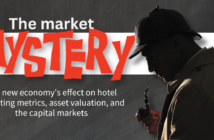Are we facing a new reality in commercial real estate financing?
Interest rates aren’t important until they are. History has taught us that nothing remains low or high forever, including interest rates, but studying historic interest-rate cycles can allow us to better appreciate and understand trends and timing. Looking back at the last half-century, the ’80s were a hyper inflationary and high interest rate era. We spent the ’90s recovering from those conditions. The first two decades of the 2000s were defined by moderate-to-low interest rates. Today, we’re in the last leg of a 50-year cycle with interest rates climbing.
INTEREST-RATE FORECAST
When it comes to inflation, the economy is like a freight train. It takes a long time to get it going and it takes a long time to bring it to a halt. This is directly correlated to how interest rates behave and how the Federal Reserve regulates its federal funds rates. Many people naively believe that rates will soon come back down. For a decrease to occur, however, there would have to be a major correction in the overall economic activity. Even if rates fall, they won’t reach zero without an economic Armageddon. For the foreseeable future, this new paradigm of interest rate environment is likely here to stay. Without a recession or an abrupt change in economic cycles, it’s fair to say that both short- and long-term interest rates will be higher in the next 10 years than they were during the past 10 years. This is the new reality.
EFFECTS ON PRICES & CAPITAL MARKETS
It’s important to understand what happens to asset prices and how capital markets react to these new challenges. When short-term interest rates go up, indices such as the one-month SOFR, prime rate, LIBOR, and the Fed funds rate also go up. Lenders funding their own balance sheets using short-term money have to charge an interest rate that is pegged to a short-term index, which follows the Fed’s movements. Therefore, when short-term interest rates rise, lenders have to increase their all-in lending rates along with the increase in the spread.
For example, if a debt fund is making bridge loans at the secured overnight financing rate (SOFR) + 500 basis points (at the time of writing SOFR is close to 4%) and historically SOFR was at 1%, the all-in rate would have been 6%. Now, just because the SOFR is at 4%, the spread can’t go down from 500 basis points to 200 points, because the actual perception of credit risk hasn’t lessened. Rather, the perceived credit risk has actually gone up because of the recessionary pressures.
In other words, there’s a double whammy in the market where economic slowdown puts upward pressure on the spread. In this example, the spread would be more than 500 basis points because of the perceived higher risk of default for the same deal to be closed this year vs. last year. This subsequently puts pressure on debt service coverage ratios – which, by definition, would mean lower loan amounts that then translate into lower loan-to-values and the need for additional equity to get deals done. Unfortunately, there’s a drag on equity returns. If the equity isn’t willing to settle on lower returns, the only other thing that can move is asset value. Asset value would be lower because of the willingness of the equity holders to pay a lower price for the returns to work. As a result, we’ll see lower-leverage transactions.
“Hospitality may be especially vulnerable, as unemployment will curb demand for leisure and business travel.”
MARKET DYNAMICS IN 2023
The biggest X-factor in the economic landscape will be jobs. If the current unemployment rate is sustainable, the pain endured will be bearable. Increased job loss, however, will have a negative spiraling effect, adding to the headwinds we already face in the higher interest rate environment. Hospitality may be especially vulnerable, as unemployment will curb demand for leisure and business travel.
In 2023, getting to the closing table will require strong relationships with capital providers on both the debt and equity side. Market knowledge and the ability to creatively structure around pain points will be pivotal for owners, developers, and general partners seeking financing, and act as the differentiating factor between winning and losing in the market. More than ever, the right investment banker or financing intermediary will prove to be the most valuable resource in the commercial real estate value chain.





